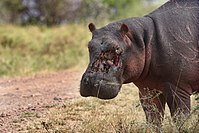
Photo from wikipedia
Abstract Free flap transfer for reconstruction of intraoral defects is a common procedure in oral and maxillofacial surgery. For tumor-related defects, the radial forearm flap is widely used for soft… Click to show full abstract
Abstract Free flap transfer for reconstruction of intraoral defects is a common procedure in oral and maxillofacial surgery. For tumor-related defects, the radial forearm flap is widely used for soft tissue restoration. However, transfer of free skin grafts to the donor site region is often required for wound closure after free flap harvesting, resulting in esthetic disturbances due to shrinkage of the grafted skin, attendant scarring, or mismatches in skin texture or color. Furthermore, free flap transfer may result in hair follicle transfer into the oral cavity, causing unfavorable intraoral hair growth in adult men in particular. Free flap prelamination can help reduce the potential disadvantages of free flaps, in terms of both flap design and size and donor site morbidity. For surgical treatment of oral cancer in middle-aged and elderly patients, eyelid dermatochalasis may present as a comorbidity leading to esthetic impairments or, in cases involving the upper eyelid, even a reduced field of view. In these cases, bilateral blepharoplasty can reduce the excess eyelid skin. The present study is the first to attempt to use excised skin after bilateral blepharoplasty as full-thickness skin grafts for radial forearm free flap prelamination. This approach combined surgical therapy of eyelid dermatochalasis with free flap prelamination, thereby avoiding the need to harvest free skin grafts from other anatomically healthy regions to close the donor site defect and preventing the accompanying disadvantages. The reconstruction results and clinical outcomes of patients revealed that radial forearm free flap prelamination using bilateral free full-thickness eyelid skin grafts was an easy and feasible method for intraoral defect reconstruction. In particular, this approach could avoid intraoral hair growth and additional skin grafting from other healthy anatomical regions, yielding good esthetic and functional results at the flap's recipient and donor sites.
Journal Title: Annals of Plastic Surgery
Year Published: 2022
Link to full text (if available)
Share on Social Media: Sign Up to like & get
recommendations!